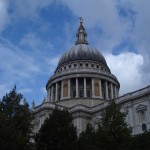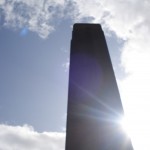September 15th, 2009 · No Comments
-
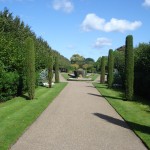
-
Regents Park
-
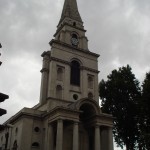
-
Christ’s Church
-
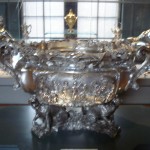
-
The Silver Exhibit in the V&A
-
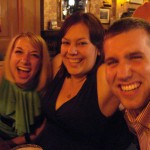
-
Having a Good Time at the Fitzroy
Like many of my classmates I decided it would be worthwhile to summarize all of my discoveries this month in London. During this post I will focus on six main themes found within London: Parks, Churches, Pubs, Other Religious Institutions, Theatre and Museums.
Parks
Each park that I visited had its own distinct characteristics that separated it from any other. Green Park was the first I visited and after perusing a few others, I realized there was nothing that exciting about it. Located right across from Buckingham Palace, Green Park certainly provides a good place to go and take a break from the busy atmosphere of the area. Besides this however there is not much going on and I would recommend that potential park goers walk the extra distance over to St. James Park.
In addition to the large number of waterfowl heckling people for food which offers consistent entertainment St. James offers some picturesque flower beds throughout and various monuments along the way. It has the relaxing atmosphere of Green Park with a bit more excitement sprinkled in.
Regents Park offers a completely different feel from Green or St. James. Located in a separate area of London, Regents Park has a history of being used by a higher end crowd. I could tell this immediately from the feel of the park. The decorative shrubbery and elegant architecture throughout gave me a feeling that Regents is not as well used as other parks.
Since I was one of the members of the Parks group that gave a walking tour of Hyde Park and Kensington Gardens I could go into a lot more detail about these two green spaces but I will choose not to in an effort to be concise. In summary Hyde Park is the largest green space in London and is often used for larger events such as concerts, festivals etc. It also contains a large number of monuments throughout including the 7/7 memorial and the Diana Memorial Fountain. Kensington Gardens is home to a variety of key monuments but is not as well trodden as Hyde. Overall it makes for a quieter atmosphere, more conducive fo reading or “snogging”.
Regents Park were my two favorite green spaces in London. Regents, is both beautiful, and extremely large and I continually felt the need to go back and explore. Kensington Gardens appealed to me in that it was quainter than Hyde Park but contained a like amount of history and monuments throughout. Although I would be content spending a length of time in any London green space Regents and Kensington would be my top choices.
Theatre
Overall I enjoyed going to the theatre on so many occasions. What better place to do so than in London after all? Here I will discuss my favorite performances and theatre venues.
All in all I enjoyed all but two of the performances we saw. The two Shakespeare productions at The Globe Theatre were fantastic. Although I did not particularly enjoy reading Troilus and Cressida it made a huge difference to be there so close to the actors. The fantastic drum chorus at the end really sealed the deal. As You Like It was probably my favorite show I saw here in London. Although it is one of Shakespeare’s simpler plays the actors really made it jump off the page. Being down it the pit was fantastic because of all the ad-libbing and constant interaction with the crowd. I even felt traces of Touchstone’s saliva on my arm at one point.
The other Shakespeare performance I saw, All’s Well That Ends Well, was lackluster. Although the Olivier was my favorite performing venue (this is what an auditorium style theatre should be like…why can’t Dickinson have something like this?) the play itself was odd and ended on an abrupt and odd note.
The other play we saw at the National Theatre, The Pitmen Painters, was fantastic. Although I was dozing a bit because of the Benadryl I took right before the show, the actors kept my attention and I appreciated that the play was based off of a true story.
Easily the oddest play we saw was Arcadia. An extremely intelligent performance the play juxtaposed two different periods in time and created a singular storyline in which the plot was based. Overall it was an entertaining performance that made me think early and often.
Finally there was Blood Brothers. The lone musical I saw produced feelings of disbelief, anguish and held back laughter. The ridiculous 80’s sound track and creepy narrator just didn’t do it for me. I think it’s safe to say that I was not the only one from Humanities 309 who was a bit surprised to see just about everyone in the audience give it a standing ovation.
I had a very positive experience with the theatre here. I would go back to the globe again and again. I loved being that close to the action. I would also enjoy seeing another show in the Olivier. There really is so much to choose from here. It’s simply a matter of figuring out your tastes and saving your money so you can see a lot of performances.
Churches
From Westminster Abbey to St. Paul’s Cathedral we saw most of the major churches/cathedrals during our month in London. St. Paul’s was easily my favorite. From the fantastic crypt to the hundreds of stairs up to the tower it had so much to offer in the way of history and mystique. Westminster Abbey fascinated me primarily because of all the literary figures that had been buried inside as well as the room that was dedicated to “The Order of the Bath”. Other churches that I really enjoyed taking a look at were: “St. Martin in the Fields” which sits just outside Trafalgar Square and Nicholas Hawkesmoore’s “Christ’s Church” which is located in very close proximity to Brick Lane.
Other Religious Institutions
Overall the Sikh Gurdwara was my favorite place that we visited. I appreciated the simplicity of the religious doctrine as well as the conviction and honesty with which our tour guide, Mr. Singh spoke. The morning was capped off with a fantastic sit down meal together in which everyone was served the same food and drink.
I had different feelings about the Hindu Mandir. It was clear to me from the very beginning that the Hindu religion is not nearly as modest as Sikhism nor are they trying to be. From the extremely decorative prayer room, to the museum located right in the center of the Mandir I never felt particularly comfortable inside.
The only religious institution I wish we had gotten a chance to visit is a Mosque. I had been to one many years ago but I did not remember a whole lot from my experience. I wonder how much more lively the East End, and all parts of London would be if Ramadan were not taking place during our time here.
Museums
I could go on and on about museums so I will attempt to stay as concise as possible.
The British Museum was massive, convenient since it was so close to the Arran House but a little one dimensional at times. One of my favorite exhibits at the British Museum was a special exhibit on Living and Dying that drew information from all different time periods and cultures.
The National Gallery was fantastic. Although I have a hard time appreciating some visual art the gallery kept my attention for a number of hours. Seeing so many famous works of art was phenomenal.
The Tate Modern was my least favorite museum here. Although I am trying I have a hard time understanding modern art. After about 45 minutes in this museum it ended up being too much for me.
The Cabinet War Rooms/Churchill Museum were two of my favorites. The realization that I was standing in one of the most important places in World War II history was unbelievable. The War Rooms felt so authentic. I really felt as though I had been taken back in time to the 1940’s while inside.
The Victoria and Albert was easily my favorite museum in London. There was so much variety inside and so much to see. I could have easily spent a few days inside. Two of my favorite exhibits were the silver and jewelry exhibits. I’m not sure what this says about me as a person but I found it unbelievable that individuals could even own such treasures. I also enjoyed the laid back atmosphere of the V&A staff. At most of the other museums I visited I felt like I was doing them a disservice simply by being there. Although I understand that taking pictures of an object in a museum doesn’t do it justice I like to be able to have the option of doing so.
The Sir John Soane museum interested me but it wasn’t really my cup of tea in the end. It also had a stuffy atmosphere to it that I didn’t really appreciate.
One thing I can draw from my experience at museums here is that each and every one has something that distinguishes it. With so many museums I thought that it would be impossible to avoid some overlap but I never really felt that. Cheers to London and its museums.
Pubs
Finally we have pubs. What would London be without it’s public houses? In some cases pubs are the true museums of London, designating what an area was like in the past and what type of clientele it attracted. During my month here I had a chance to visit a few pubs and get a general sense of what some possible differences could be. It is clear to me that each pub brings something different and unique to the table. The Marlborough Arms was convenient being so close to the Arran House and was a great place to enjoy a pint over a meal with friends. The Court was conducive to socializing in a different way. The music was louder, the people louder and the drinks cheaper. Other places I visited offered other things that made them stand out as well. One thing that i’ve learned about pubs is that it’s hard for one to please everyone. Since everyone has different tastes and desires when it comes to pubs you are better off going to one with a small cohesive group.
To conclude this novel I would just like to say that I think we saw a lot of different faces of London this month. I realize there is much more to see here but between walking tours throughout the city, trips to major monuments and museums and individual exploration I have learned a ton about London, it’s history and where it is going. I look forward to more London explorations in the future but for now, ON TO NORWICH!
Tags: Churches and Cathedrals · Henry · Pubs · Theatre
September 14th, 2009 · 1 Comment
During our time in London we’ve had the opportunity to attend many theatre performances. As I chose to see the optional plays as well, the total count comes to 6: Troilus and Cressida, Arcadia, All’s Well That Ends Well, As You Like It, Pitmen Painters, and Blood Brothers. Although I could probably write an entire paper on each of the plays, I would actually like to discuss the three Shakespeare plays I saw, especially the differences in the theatres where they were performed: The National Theatre and Shakespeare’s Globe.
The first Shakespeare performance we saw was Troilus and Cressida. To be honest, I wasn’t all that excited about the story when I read the play over the summer as it was not as engaging as his more famous plays I was familiar with already. Therefore, I wasn’t too excited to stand for three hours through a play that I thought would be rather boring. The experience at the Globe was exactly opposite of what I was expecting, though. I loved being so close to the actors that I could see every minute facial expression. Seeing the live performance was also much more entertaining than reading it and I learned that you really must see a Shakespeare play to truly appreciate all of the subtleties that are often lost in the text.
All’s Well That Ends Well was performed in the Olivier Theatre of The National Theatre. The Olivier seats about 1200 people and is styled after a Greek amphitheatre. During our tour of the National Theatre, we learned that this semi-circular shape allows the actors to maintain a connection with the entirety of the audience. While this may be a better set-up than the raised stage in the front, especially for Shakespeare, one still has the experience of the lights going down and watching the events unfold from afar. I definitely did not feel a personal connection with the actors and at many points I could barely see their faces or expressions. Overall, I felt kind of far away and uninvolved. I found the play to be mediocre. It had some funny parts, but none were all that “laugh-out-loud.” I don’t necessarily think that this play was any worse than Shakespeare’s other plays as it is such a well-known title; I simply think I felt disengaged with the performance.
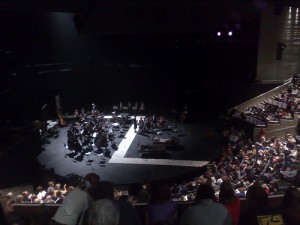
The Olivier
As You Like It proved to me my love for Shakespeare’s Globe. This performance was so incredibly interactive I enjoyed every second of it. At first, I regretted opting for the groundling ticket as I had just come from giving my walking tour, but I later came to realize it was the best place to be for the performance. During the play, the actors walked through the audience and even acted out the wrestling scene in the front of the groundling section. There were numerous points during the show when the actors made side comments about the audience that could not be heard from the seats farther away.
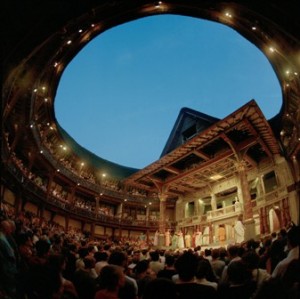
The Globe
The style of the stage at the Globe is the way Shakespeare intended his works to be performed. We’ve heard some criticism about the Globe, especially from A.N. Wilson, because of its links to Disney, its appeal to tourists, etc., etc. I don’t necessarily disagree with such observations, but I do think the Globe deserves some justification. There are few venues where one can see Shakespeare’s plays performed in this manner, and frankly I feel this is the best way to see these performances.
Tags: Sarah · Theatre
September 14th, 2009 · No Comments
Although I have blogged, to some extent, about most academic things I have done in London, I feel that I have a better impression of most things now than I did at the beginning of the stay. Along this vein, I feel the need to revise, or just plain state, my opinions on the “Big Five” topics – parks, churches, museums, theatres, and pubs.
I have now been to five of the Royal Parks in London. Green Park, Kensington Gardens, Hyde Park, Regent’s Park, and St James’ Park are all very similar and yet very different in their own ways. I found Green Park, situated very close to Buckingham Palace, to have the most unfriendly atmosphere of the five. There is very little to Green Park. There are trees, benches, grass, the ever-popular lawn chairs for rent, and beautiful ornate gates facing Buckingham Palace. I think the reason I found the park so cold is that it was, well, too green. There were no flowers or water features (except for one fountain commemorating the Canadians), just trees, grass, and benches.
This is vastly different from the other four parks I visited. St James’ Park, Hyde Park, Regent’s Park, and Kensington Gardens all were beautifully landscaped with brightly colored flowers, clean fountains, scultpures, and natural or constructed water features. In Hyde Park, Regent’s Park, and Kensington Gardens it was easy to forget that you were in the middle of a pollution-filled city. As I am not much of a city person, it was extremely refreshing for me to not be able to hear or see traffic for a while. With Green Park and St James’ Park, I couldn’t shake that feeling. However, I am a firm believer that parks, whether or not they are within city limits, always make people feel healthier. For this reason and the sheer beauty that the parks portrayed in their different ways, I understand why I did not only see tourists, but the people of London as well.
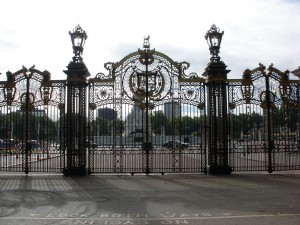
Gates towards Buckingham Palace from Green Park
Churches and other places of worship are an integral part of societies throughout the world. Throughout our time in London, we have been fortunate enough to visit Westminster Abbey, St Paul’s Cathedral, a Sikh gurdwara, and a Hindu temple. Of these four I enjoyed St Paul’s Cathedral the most from a purely historical standpoint and the Hindu temple most from a cultural perspective. St. Paul’s is one of the most recognizable and interesting buildings in London. It not only houses some of the most important military remains in the country (the Duke of Wellington and Admiral Nelson), but it was one of the most iconic images of WWII Britain. I also found it to be less like a museum where I felt like hop-scotching around graves in the floor (Westminster Abbey) and much more like a place of worship.
I enjoyed the Hindu temple for very different reasons. Although there was a definite sense of it being a tourist attraction, with the gift shop in the lobby and the interpretive centre with tiny models of Hindu gods, the temple was still very obviously, well, a temple. Before going there, I had no idea what Hinduism was like. I knew that there are multiple gods and that one is an elephant, but I didn’t know about their dedication to peace and volunteer work. What really struck me about it was that the intricate carving and craftsmanship of the facility was all done by volunteers. I think that this cultural experience was only heightened by being able to observe a service in the sanctuary that was so unlike my own Roman Catholic faith.
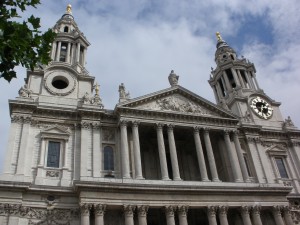
St Paul's Cathedral - a symbol and a place of worship
I had very mixed experiences with museums in London. Some, like the Victoria and Albert, I just didn’t seem to understand in the amount of time I spent there. However, I think that if I went back and dedicated a day to the facility, I would appreciate how the seemingly-random exhibits link together much better. (I did enjoy the items on display in the V&A, I just had an issue with the layout of the museum.) Other museums, like the Museum of London and the Docklands Museum, were put together in a very fluid and informative manner that I enjoyed greatly. My two biggest museum issues were with the British Museum and Sir John Soane’s Home/Museum. Grace and I wrote extensively on our thoughts on the British Museum, so instead of repeating everything, I’ll just give a brief summary: why are all of these amazing artifacts that have no connection to Britain in the British Museum?
The Sir John Soane Museum is a completely different story. I appreciated that the museum was free and displayed an extremely eclectic collection, but please never make me go back there ever again! It was the single most claustrophobic place I have ever been in my entire life with possibly one exception. Call it a personal thing, I do not like it when random pieces of monuments are mounted on the ceiling directly above my head. I am also not a big fan of walking into a room in a house and having literally hundreds of sculpture eyes staring at me from every surface around me. I disliked it so much that I could not even finish going through it, and anyone who has been in a museum with me will know that I read and see as much as I possibly can. I don’t understand why that creepy building perfectly-suited to be a haunted house at Halloween is called a museum. (Please if you can attempt to explain it to me, go right ahead!)
Theatre is a subject I have talked about in a couple of different posts (Observations on Accessibility and Blood Painters and Pitmen Brothers), however, I have not discussed theatre in general. I was lucky enough to see Troilus and Cressida, All’s Well That Ends Well, Arcadia, The Pitmen Painters, and Blood Brothers. Each of these theatre experiences were extremely different, but all valuable in their own ways. Troilus and Cressidawas shown in the Globe Theatre and we had groundling tickets that forced us to stand for the 3 hour performance. The actual standing wasn’t nearly as bad as I thought it would be, but the best thing about the show was being quite literally three-to-four feet away from the actors on stage. (Actually, it was slightly amusing when Hector died and was lying 3 feet away in our line of sight for the last 20 minutes of the play!) The staging of this Shakespearian play was vastly different to All’s Well That Ends Well, which was put on in the National Theatre. In the Globe, the sets are quite minimal because they have to perform four or five different shows on the same stage in the space of a few days. The set for All’s Well That Ends Well was much more elaborate and specialized for the show. Rather than the reliance on the actors and the costumes that the Globe used to tell you where the play was occurring, All’s Well That Ends Well used a dark set with elaborate staircases to add to the mood of characters and the dialogue.
Much like with Troilus and Cressida, the set for Arcadia was also pretty simple. Although the play took place in two different years, it was set in exactly the same room with almost all of the same props. This was a very effective way to stage the show and allowed for the writer, Tom Stoppard, to do some very interesting things with the characters from both time periods, like when he had them all in the room at the same time, oblivious to each other. I particularly enjoyed the way that this play was set and how basic it was. It was vastly different from the more complicated sets of The Pitmen Painters, which included projection screens, and Blood Brothers, which had lots of windows for the Devil/God character to peer creepily out of.
This final subject I have not blogged about at all. Pubs are an integral part of British culture. That said, pubs are also an integral part of Irish culture, so I experienced pub life when I lived in Ireland. British pubs and Irish pubs have a lot of similarities and differences. In both places, you must push viciously up to the bar in order to get your food and drink, you have to be 18 to have alcohol, smoking must be done outside, and there are usually way too many people in the pub for you to feel comfortable. Oh, and you always pay way more than you think you should for your drink. I’ve been to a couple of pubs in London and have found that they are all fairly similar. The bartenders are nice, but kind of frantic; the food is good, and usually relatively cheap; and the music is God-awful 1980s or techno playing at volumes that are way too loud. The first two are cohesive with pretty well every Irish pub I’ve ever been in, the third is not. Irish pubs play good music… or at least much better music than I’ve heard here! There are a lot of pubs that have a band playing traditional Irish music in front of you in the pub for pints and there are also a lot that play modern music at volumes that make my ears want to cry – but at least the music isn’t a Cher and Meatloaf duet accompanied with the weirdest music video I have ever seen in my entire life. (This particular musical masterpiece was played in The Court the other day. I never would have thought of that particular combination, but oooooookkkkkkkkkk.) Truth be told, I just want to find a comfortable pub with some good music and that will make me just as happy as George Orwell’s fictitious Moon Under Water.
Tags: Churches and Cathedrals · Kelley · Museums · Pubs · Theatre
A couple weekends ago, a fellow classmate informed me that William Shakespeare is the best author of all time. Though I disagreed wholeheartedly with him, it seems that I am in the minority on this point in London. Shakespeare hasn’t been alive for many years now but (as many people have noted before me) his presence is still incredibly pervasive in English life. The revised version of the Globe Theater is filled nightly with people clamoring to get a taste of the authentic Shakespeare experience. Right across the river, the National Theater makes sure to have a Shakespeare play in its rotation regularly- something that is always well attended. After watching an entertaining but incredibly over-the-top version of Troilus and Cressida, I was prepared to write a blog about how Shakespeare in England has turned into just another tourist attraction. I paid more attention to the audience at the National Theater’s presentation of All’s Well That Ends Well though and realized that I saw more people than those who toted fanny packs around the city all day (items that I’m happy to report I have seen only a small number of). The over one thousand seats that the theater has were filled with more than a few tourists but also many who actually knew what the correct response to ‘cheers’ is (something that I’m still trying to figure out). So what? Two major theaters are showing Shakespeare plays- is that so exciting? Maybe not. But walking along the streets, you are guaranteed to see big posters advertising for Jude Law in Hamlet, Judy Dench in A Midsummer Night’s Dream, and other celebrities in lead roles in Shakespeare’s plays. Clearly, the man is still alive and well in London. Again, this might not seem that interesting considering he is known as such an infamous figure not only in the arts but in history in general. But the man has been gone for over 300 years now! Many other playwrights have produced excellent works (some that are arguably even better than anything Shakespeare has ever written) yet none of them have their shows playing in multiple theaters across the city or in annual festivals. I can’t accept that his popularity still hinges on the fact that he’s Shakespeare. Even the brightest star eventually fades away. I wonder the attraction and/or loyalty to the bard isn’t more a devotion to something else- a devotion to a desired ‘English’ identity that is found in the infamous Shakespeare. This may be a stretch but it could be an interesting point to consider.
While I was surprised to see so many London locals interested in seeing a Shakespeare play, the audience was not an incredibly diverse one at either show. The locals that were at the show were seemingly (by this untrained eye’s standards) predominantly middle-upper class, white, elderly people. There are exceptions to every rule, but this was the crowd that I most observed while there. This isn’t to say that the theaters were too pricey for the majority of Londoners. You can buy a ticket to stand in the Globe for five pounds and a ticket to sit in the National Theater for ten. While some might not have money to throw away to the theater, five pounds for entertainment is truly reasonable. Still, despite the reasonable prices, the crowd that was attracted to the show seemed to be of a certain stature. I think it’s also worth noting that neither of these shows is considered one of Shakespeare’s big hitters and yet each theater was filled as one might expect for a Hamlet or Macbeth production. Clearly it’s not the show that is so attractive but rather the playwright. And why? I would argue that Shakespeare represents an identity of old London. He represents a more homogeneous London. London today is anything but homogenous. It’s incredibly diverse and is only becoming more so with each day that passes. With the word of the trip being ‘juxtaposition’, this diversity and change is clear to even the eye of an outsider. Is holding onto Shakespeare as an image for the ‘good ol’ England a means of coping with these changes? England has had many famous icons throughout its history but few (that I’m aware of) have been so closely connected to their national pride/make-up. So while the Beatles might have brought fame to the country, Shakespeare painted a picture of what English society was like. It was a society that may have been full of class division but one that knew the Classics, was incredibly mannerly, and conversed in witty and intelligent ways. Is Shakespeare’s continued prevalence a means of keeping that identity in place? I’m not entirely certain. An argument could be made on either side. Maybe people truly never tire of his shows. I would suggest that after three hundred years, picking up some Tennessee Williams or Eugene O’Neill might be a good idea.
Tags: Audrey · Theatre
London is a city where the past is constantly present. What do I mean by that? Different countries maintain a dialogue with their history in a different way. Some countries are older than others. For example, in Argentina, where I come from, there are some plaques and monuments, but not so many as in England. One of the obvious reasons is because Argentina is a much younger country of only 200 years, and therefore has less history. But I do not think this is the main reason. In London, I get a feeling that time is cyclical, and that history comes back to us in many forms and shapes. We see it present on the street, in houses, in museums, in pubs and in its people.
During our trip, Prof. Qualls has been using the word juxtaposition. Indeed, in London we have found that not only architecture presents juxtaposed old and new buildings, but also different situations, like the helicopters during our play at the Globe theatre. I want to use a more complicated word which I am not sure if I made up since I am translating it from Spanish: trans-textuality. By this I mean the dialogue between two texts or two authors. While this is common in literature since most texts have their foundations on previous texts, it is a technique that is most common in Shakespeare and that I’ve been founding in London in general. This idea that if we build a new building, we will find the remains of others. Like we saw on our Roman walking tour. If a family moves to a new house, they will probably discover who lived there, like we saw in our Bloomsbury walking tour, and the many plaques saying the personalities who lived in the different houses. If I go see a play, trans-textuality is always there. It can be Troilus and Cressida, a story built inside another story (the Trojan war), or Arcadia, by Tom Stoppard, which also dialogues with the past and real life English characters such as Lord Byron.
Being in a city as old as London makes me constantly question about the past, from who has lived in what we now know as the Arran House Hotel, to what will my mark be, as the story of London progresses.
Tags: Azul
Tonight I went to the play All’s Well That Ends Well which was preformed at the on the Olivier stage at the National Theater. Though I greatly enjoyed the performance of the play, I question Shakespeare’s choice for the title.
(spoiler alert) The play began with the main character, Helena (who loves Bertram), cures the King of France of his illness and is therefore granted the choice of any man she desires for her husband. So naturally she chooses Bertram, whom does not like Helena (mostly on account of her social standing) and is appalled by the thought of taking her hand in marriage. However, he cannot turn down Helena’s marriage proposal by the King’s decree, so instead he decides to become a soldier and leaves Helena before he beds her. After leaving he sends Helena a letter saying that he will have no wife in France until Helen is impregnated with his child and possesses his family ring. After reading this Helena leaves France in search of her husband. When she arrives in Florence (where the war is) she decides to stay with an old widow and her daughter, Diana (with whom Bertram is in infatuated). She then convinces Diana to seduce Bertram and to blind fold him before Helena comes in and makes love to him (Bertram still believing that he is with Diana). So, through Diana Helena comes to possess Bertram’s ring and becomes pregnant with his child. At the end of the play she confesses what she has done and Bertram vows to always love her, yeah right!
All is not well at the end, for Bertram is still a jerk and Helena is still married to him. This is the classic story of many present day teen pregnancies: boy does not like girl so girl decides to trap boy by forgetting to take her pill (opps!) and boy is stuck putting up with girl until the child is raised. In All’s Well That Ends Well is Shakespeare trying to suggest that this method of entrapment actually effective? Or is he poking fun at those who believe it to be effective? Neither of these options make the play contingent with the play’s fairytale motif. Also, both options make this comedy funny only in a very twisted way.
I can see why this play is considered one of Shakespeare’s problem plays. Like Troilus and Cressida, it seems to confuse and confound the audience. Why did Shakespeare choose to make a mockery of the Greek and Trojan heroes in Troilus and Cressida? And why did he choose to name a tale about a teen pregnancy All’s Well That Ends Well?
However, I can see the value in All’s Well That Ends Well as a social commentary. Though the King assures Bertram that he will personally boost Helena’s position in society, Bertram still does not want to marry her because she is the daughter of a poor physician and he is a count. This reflects the English society’s belief at the time that a person’s class is permanent and does not change from the day they are born to the day that they die. The fact that Bertram finally accepts Helena once she is pregnant also reflects the norm of the time: that if a man impregnates a woman then he is forever after responsible for her well-being. In All’s Well That Ends Well Shakespeare uses these two social to show the disjointed nature of the British upper-class’ social rules. In this way I feel that Shakespeare is trying to critique the contradictory nature of these social guidelines. I am very interested in how other people read this play.
Tags: Rebecca · Theatre
Possibly one of the most personally thrilling aspects of being in London are our ventures out to its numerous theatres. I have always enjoyed the performing arts – backstage, onstage, and in the audience. Besides finding performing onstage a thrill, I enjoy theatre for its ability to transport, reflect, commentate, and juxtapose. It takes a subject (society, culture, science, etc) and turns it into a picturesque/edgy/nonsensical/expressive form for an awaiting audience. Some interact with the audience face-to-face, while others prefer to let the audience engage with the performers from their seats. Either method has its immediate advantages and disadvantages, but both demand some reflection.
London has provided several different uses for theatre. I guess it sounds odd to see theatre as a “tool”, but it undoubtedly has some uses. Take, for instance, the plays of Noel Coward (the subject of my research paper). His plays (usually comedies) make some social commentary of British society during the 1920s, 30s, and 40s – the time during which he wrote his plays. Theatre can be used as ways to mock, mimic, reflect, or reinforce themes found recurring in society. Even today, we learned about the play An Inspector Calls from Rick Fisher, the show’s lighting designer. As a commentary on wealth and the prevalence of blissful ignorance, this play aims, in part, to lead the audience towards some sort of understanding of self-reflection and self-improvement. Certainly a single show does not always solve these issues, but J.B. Priestley – the author – certainly saw the point of confronting them.
On the other hand, theatre can, and does, entertain. Take the list of musicals available in the West End. Several are highly entertaining and well-done. No, they do not always include profound thought or interesting social commentary, but the story is usually popular and well received. Some are edgy, but many have glitz and glamour and are eagar to please audiences (e.g. Legally Blonde the Musical). I can’t really argue that this theatre is useless and without meaning – primarily due to the fact that I have seen some of the shows on that list (I am still holding out on Sister Act the Musical, though. Don’t worry.).
But London theatre also combines the two in order to deliver entertaining yet serious shows. The two shows we have seen – Shakespeare’s Troilus and Cressida and Stoppard’s Arcadia – exemplify their successful combination. Both reflect on the ways of the past and comment, albeit loosely, on British society. Both entertain their audiences by pricking their minds and engaging their attention through clever language or comedic timing. Both frustrate and confuse their audiences due to fast-paced or even outdated language. Both step into the far reaches of complex issues ranging from love and thermodynamics. Both were enjoyable in this way, or, at the very least, deserving of some appreciation as works of performance art.
Theatre has several universal properties (namely the several noted above – social commentary, entertainment, etc.). London has adapted these properties to fit its own diverse audiences by providing a long list of plays, musicals, and other forms of performance art in the theatre. Each has its own purpose. Each attracts a different type of London theatre-goer. I often walk outside the auditorium during intermission simply to look around and listen to the other people around me. These people may or may not be seeing the same show that I am watching. It’s at this point in my experience of London theatre that I wonder who you can really pin down as a London theatre-goer. Can you even identify them?
I hope my next outing to see All’s Well that Ends Well will help bring me closer to providing an answer.
**The title of the post is a quote from Tom Stoppard’s Arcadia.
Tags: Brandon
As I continue to explore London more and more I realize just how vast and widespread this place is. Before our class took a walk through Southwark on Friday morning I realized I had not even been close to where we were that day. There is so much to do here and it would take years and years to truly get a sense of what all London has to offer. Over the past few days i’ve been trying to conquer as much as London as possible. During Friday and Saturday I spent most of my time conquering museums and theaters.
I’ll start with museums. On Friday after our walk of Southwark I headed out to lunch with a fairly large group of people. After our lunch I had a hard time shaking off a bout of sudden tiredness. I figured a trip to the Tate Modern would remedy this. I’m not afraid to admit that I was wrong.
Modern art is an interesting beast. As much as I’ve tried still I have a hard time understanding it. Despite this statement in no way am I critical or judgemental of anyones work. As someone who has basically no experience/background with modern art I have no right to say anything negative about someone’s art, I simply just can’t grasp it. Walking around through the first few galleries of the Tate Modern I wandered, I sat, I stared, but still found nothing. I asked Brandon his opinion about some of the artwork and this helped. Talking to someone who has taken classes in the subject and is passionate about it was definitely a good choice and I learned a lot but after some more musings I still found nothing. Perhaps it was the drowsiness, perhaps it was the absurdly sexually explicit video I witnessed in one section of the museum but soon after entering I realized I had seen enough of the Tate Modern.
Since many other people in our class had seen the Cabinet War Rooms and the Churchill Museum earlier in the week I figured the afternoon would be a great time to see both of those. This time I was right. From the moment I entered the doors I had a feeling I would enjoy walking through this dungeon of secrets. Although I would never want to be stuck down there for long periods of time I was amazed at how well intact the war rooms were. As I walked through the narrow hallways I had an eerie feeling that I was sent back in time to the early 1940’s when Churchill used the space frequently during the Blitz to hold meetings and conduct secret business. My favorite part of the war rooms was the tiny room that Churchill put 11 secretaries in. According to the audio tour despite the close proximity to each other he expected immaculate work from every single one of these women and did not hesitate to fire them if they were not pulling their weight.
After the tour of the War Rooms I spent a bit of time in the Churchill museum before my fatigue caught back up to me. I decided it would behoove me to head back to my room and rest for a little bit before preparing for the performance of “Troilus and Cressida” that we would be attending that night at the Globe Theatre.
After getting off at the St. Paul’s tube stop and scurrying across the Millennium Bridge Brandon, Aidan and I made it to the performance about ten minutes early. Just enough time to catch our breath and prepare for the real ordeal: standing for three hours. Despite my concerns going into the performance in retrospect being a “groundling” was not that bad at all. My feet were certainly a little uncomfortable by the end of the night but being so close to the action on the stage certainly made up for that. I really enjoyed the performance overall. Matthew Kelly’s portrayal of Pandarus was phenomenal and Paul Hunter (Thersites) left me in stitches for most of the night. While reading the play beforehand I did not enjoy it all that much. It’s amazing how easily and completely transformed a play can become however once performed versus just read. My experience at the globe was great and I hope to go back and see another show before I leave London.
Walking back over the Millennium Bridge that night to the beautiful view of St. Paul’s across the Thames I concluded a few things. The first being that London is even more stunning at night than it is during the day. The second being that i’m not going to enjoy everything I see here in this city and I have to come to terms with that. I have been lucky so far on this trip that very few things have disappointed me. I realize I have to be ready to be surprised both negatively and positively with encounters I have, places I go and things I learn. Like everything else in life London is not perfect nor should it be.
Tags: Henry · Museums · Theatre
This was initially a comment on Audrey’s wall, but I realized I hadn’t written my own blog post yet, and (more importantly) I was getting a bit preachy. So here it is:
I would first like to say that a city devoted to capitalistic endeavors is a beautiful thing. I look around and everywhere I see touristy traps– places trying to make you pay for restaurant seats and churches. Bath was no different, save for its own self recognition. It didn’t try to be anything it wasn’t. You want to drink our fancy water, you bet your ass you’re paying money. So hats off to you Bath and your unashamed stance, don’t ever apologize!
I, like Audrey and fellow travelers, tried to find the quintessential “Bath.” Far beyond the wrenching grasp of the tourist industry. I wasn’t looking for anything beautiful though, on the contrary. I attempted to walk to streets further into the realm of residential. I found parks with no names, pubs with local patrons drinking at 2 in the afternoon, and shady alleyways with no pretty walls or paintings of any kinds. It was no landscape shot, but there was a beauty in the simplicity. Sadly, I had no idea how to get home and wondered aimlessly for quite a while until like a beacon of hope I ran into Professor Qualls, who told me I was only a turn away from the church (I swear I had been wondering for a long time).
My love of Celtic heritage made going to Stonehenge cool. I mean the curiosity of the whole thing was pretty cool, especially seeing how the English lady on the head set phrased their speculation on its purpose. Honestly, I thought they weren’t very culturally relative: they kept applying a few modern ideas to the potential purpose. The thought that Stonehenge would be a symbol of power with other purpose seems a bit silly. Further, they kept bringing up concepts of hierarchy, which is complete speculation. Anyway
Next big thing was Borough Market, which was incredible. I have found my new love, sorry Planet Organic. How busy and hectic it was. The mushroom dip was especially delicious. Anything from Kangaroo burgers to a bottle of red wine can be found there.
I can’t exactly remember chronological order, but we saw Troilus and Cressida at the Globe Theatre, and I was quite happy with it. I felt they leaned a little too hard on the comedy side, but I was in a strange mood when I read the play initially. All the actors were fantastic and the visual aspects of the people were quite engaging. It is always interesting to read works based around the Trojan War. I remember when I was but a wee-lad, and my grandmother read the Illiad to me, thinking how amazing Achilles was and not really caring about Hector too much, but as I matured and read the work again by myself I began to sympathize more and more with him and less so with Achilles, which I think is the idea. Both warriors are bound by a sense of honor and fate. After watching this preformance, I felt that Hector was almost more enslaved to his sense of duty than Achilles was to his pride.
The British Museum was pretty cool, and I think I finally get what everyone else has been feeling. When I was at the National Art Gallery, Paul stopped me to point out Sunflowers, by Van Gough, and I wasn’t really sure what to say. Cool? But when I was at the British Museum, I came across something called the Dancing Shiva (http://dustysojourner.files.wordpress.com/2009/06/shiva_nataraja_musee_guimet_25971.jpg). Last semester I had been one tequilla shot away from having the thing on my back (which doesn’t always mean it has any value to one at all but in this case it did). I’m not sure why, but it’s a symbol I have always connected with. The Nataraja is meant to represent the destruction of the universe through Shiva’s crazy dance moves, but it is also meant to show the oneness of the universe. So there I was, standing in front of this bronze statue feeling as giddy as a little school girl, awesome.
The Cabinet War Rooms and the Churchill Museum. What to say? The Brits love their Churchill. One of the first lines in the head set was something along the lines of Hitler and Churchill both had a cabinet, but Churchill never overroad his. Why bring Hitler into this? The other thing that made me chuckle was when they were retelling the story about the hole punch. Churchill basically chews out this secretary because he uses weird words and she couldn’t figure out what he meant, and then the head set said: but he had a lot of pressure, so it’s ok. Not ok Churchill, not okay. Overall, the museum was a giant pat on the back for the Brits and their ability to live in small rooms for a long time. Seeing where they lived was neat, but it wasn’t incredibly informative and despite having creepy wax figures and listening to recordings, I never felt enveloped in the way, I think, they wanted to make the guests feel.
As a note, make sure you ask the ticket guy for a receipt because they don’t give you one otherwise, and there is no way to be refunded without it– your ticket isn’t enough, and the museum isn’t worth the ten quid.
Anyway, cheers
Tags: Andrew R
I have to admit that I have not been to many plays in my life. As a matter of fact, the last play I remember attending was in middle school. If I recall correctly it was “Romeo and Juliet,” but I do not remember the performance at all. Fortunately, tonight we were able to see “Troilus and Cressida” in the Globe Theatre. At first, I was a bit apprehensive about standing for three hours and I am sure I wasn’t alone in that regard. Though that is what a “groundling” had to do and trying to recreate it makes The Globe historically accurate, I would have greatly appreciated a chair. Nevertheless, despite the lack of chairs and occasional rain, I thought the play was fantastic.
Every actor did a phenomenal job, the music was incredible and the props were well created. There were too many humorous scenes to mention, but overall the way in which the play was done was amazing. In particular, I thought the fight scenes were very well done. I also enjoyed the drums at the end, which was very unexpected. Perhaps because of all this, I did not realize at the end that three hours had passed. The entire performance was so mesmerizing that it just took me in.
Since I am so used to seeing entertainment through a screen, live acting was a treat. It seemed so much more authentic; the actors were right in front of you and they commanded your attention. I am excited to see more plays while in London and take this new passion back to the States.
Tags: Andrew F









